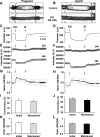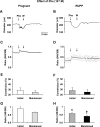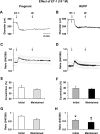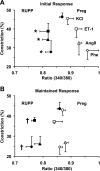Differential [Ca2+]i signaling of vasoconstriction in mesenteric microvessels of normal and reduced uterine perfusion pregnant rats
- PMID: 18843089
- PMCID: PMC2685295
- DOI: 10.1152/ajpregu.90523.2008
Differential [Ca2+]i signaling of vasoconstriction in mesenteric microvessels of normal and reduced uterine perfusion pregnant rats
Abstract
Vascular resistance and blood pressure (BP) are reduced during late normal pregnancy (Norm-Preg). In contrast, studies in human preeclampsia and in animal models of hypertension in pregnancy (HTN-Preg) have suggested that localized reduction in uterine perfusion pressure (RUPP) in late pregnancy is associated with increased systemic vascular resistance and BP; however, the vascular mechanisms involved are unclear. Because Ca2+ is a major determinant of vascular contraction, we hypothesized that the intracellular free calcium concentration ([Ca2+]i) signaling of vasoconstriction is differentially regulated in systemic microvessels during normal and RUPP in late pregnancy. Pressurized mesenteric microvessels from Norm-Preg and RUPP rats were loaded with fura 2 in preparation for simultaneous measurement of diameter and [Ca2+]i (presented as fura 2 340/380 ratio). Basal [Ca2+]i was lower in RUPP (0.73 +/- 0.03) compared with Norm-Preg rats (0.82 +/- 0.03). Membrane depolarization by 96 mM KCl, phenylephrine (Phe, 10(-5) M), angiotensin II (ANG II, 10(-7) M), or endothelin-1 (ET-1, 10(-7) M) caused an initial peak followed by maintained vasoconstriction and [Ca2+]i. KCl caused similar peak vasoconstriction and [Ca2+]i in Norm-Preg (45.5 +/- 3.3 and 0.89 +/- 0.02%) and RUPP rats (46.3 +/- 2.1 and 0.87 +/- 0.01%). Maximum vasoconstriction to Phe, ANG II, and ET-1 was not significantly different between Norm-Preg (28.6 +/- 4.8, 32.5 +/- 6.3, and 40 +/- 4.6%, respectively) and RUPP rats (27.8 +/- 5.9, 34.4 +/- 4.3, and 38.8 +/- 4.1%, respectively). In contrast, the initial Phe-, ANG II-, and ET-1-induced 340/380 ratio ([Ca2+]i) was reduced in RUPP (0.83 +/- 0.02, 0.82 +/- 0.02, and 0.83 +/- 0.03, respectively) compared with Norm-Preg rats (0.95 +/- 0.04, 0.93 +/- 0.01, and 0.92 +/- 0.02, respectively). Also, the [Ca2+]i-vasoconstriction relationship was similar in KCl-treated but shifted to the left in Phe-, ANG II-, and ET-1-treated microvessels of RUPP compared with Norm-Preg rats. The lower agonist-induced [Ca2+]i signal of vasoconstriction and the leftward shift in the [Ca2+]i-vasoconstriction relationship in microvessels of RUPP compared with Norm-Preg rats suggest activation of [Ca2+]i sensitization pathway(s). The similarity in vasoconstriction in RUPP and Norm-Preg rats suggests that such a [Ca2+]i sensitization pathway(s) may also provide a feedback effect on Ca2+ mobilization/homeostatic mechanisms to protect against excessive vasoconstriction in systemic microvessels during RUPP in late pregnancy.
Figures





Similar articles
-
Downregulation of microvascular endothelial type B endothelin receptor is a central vascular mechanism in hypertensive pregnancy.Hypertension. 2014 Sep;64(3):632-43. doi: 10.1161/HYPERTENSIONAHA.114.03315. Epub 2014 Jun 9. Hypertension. 2014. PMID: 24914193 Free PMC article.
-
Enhanced [Ca2+]i in renal arterial smooth muscle cells of pregnant rats with reduced uterine perfusion pressure.Am J Physiol Heart Circ Physiol. 2003 Jan;284(1):H393-403. doi: 10.1152/ajpheart.00247.2002. Epub 2002 Sep 12. Am J Physiol Heart Circ Physiol. 2003. PMID: 12388289
-
Increased Ca2+-dependent intrinsic tone and arterial stiffness in mesenteric microvessels of hypertensive pregnant rats.Biochem Pharmacol. 2023 Feb;208:115353. doi: 10.1016/j.bcp.2022.115353. Epub 2022 Nov 24. Biochem Pharmacol. 2023. PMID: 36435203 Free PMC article.
-
Regulation of vascular angiotensin II type 1 and type 2 receptor and angiotensin-(1-7)/MasR signaling in normal and hypertensive pregnancy.Biochem Pharmacol. 2024 Feb;220:115963. doi: 10.1016/j.bcp.2023.115963. Epub 2023 Dec 5. Biochem Pharmacol. 2024. PMID: 38061417 Free PMC article. Review.
-
Vascular and cellular calcium in normal and hypertensive pregnancy.Curr Clin Pharmacol. 2009 Sep;4(3):172-90. doi: 10.2174/157488409789375320. Epub 2009 Sep 1. Curr Clin Pharmacol. 2009. PMID: 19500073 Free PMC article. Review.
Cited by
-
Sex-related decrease in [Ca2+]i signaling and Ca2+-dependent contraction in inferior vena cava of female rat.Am J Physiol Regul Integr Comp Physiol. 2010 Jan;298(1):R15-24. doi: 10.1152/ajpregu.00465.2009. Epub 2009 Oct 28. Am J Physiol Regul Integr Comp Physiol. 2010. PMID: 19864336 Free PMC article.
-
Molecular and vascular targets in the pathogenesis and management of the hypertension associated with preeclampsia.Cardiovasc Hematol Agents Med Chem. 2010 Oct 1;8(4):204-26. doi: 10.2174/187152510792481234. Cardiovasc Hematol Agents Med Chem. 2010. PMID: 20923405 Free PMC article.
-
Reduced uterine perfusion pressure as a model for preeclampsia and fetal growth restriction in murine: a systematic review and meta-analysis.Am J Physiol Heart Circ Physiol. 2024 Jul 1;327(1):H89-H107. doi: 10.1152/ajpheart.00056.2024. Epub 2024 May 17. Am J Physiol Heart Circ Physiol. 2024. PMID: 38758122 Free PMC article.
-
Evaluation of Arteriolar Smooth Muscle Cell Function in an Ex Vivo Microvascular Network Model.Sci Rep. 2017 May 19;7(1):2195. doi: 10.1038/s41598-017-02272-4. Sci Rep. 2017. PMID: 28526859 Free PMC article.
-
Estrogen receptor subtypes mediate distinct microvascular dilation and reduction in [Ca2+]I in mesenteric microvessels of female rat.J Pharmacol Exp Ther. 2015 Feb;352(2):291-304. doi: 10.1124/jpet.114.219865. Epub 2014 Dec 3. J Pharmacol Exp Ther. 2015. PMID: 25472954 Free PMC article.
References
-
- Alexander BT, Kassab SE, Miller MT, Abram SR, Reckelhoff JF, Bennett WA, Granger JP. Reduced uterine perfusion pressure during pregnancy in the rat is associated with increases in arterial pressure and changes in renal nitric oxide. Hypertension 37: 1191–1195, 2001. - PubMed
-
- Alexander BT Divergent origins of slow fetal growth: relevance to adult cardiovascular disease. Hypertension 50: 465–466, 2007. - PubMed
-
- Alexander BT Placental insufficiency leads to development of hypertension in growth-restricted offspring. Hypertension 41: 457–462, 2003. - PubMed
-
- Allahdadi KJ, Walker BR, Kanagy NL. ROK contribution to endothelin-mediated contraction in aorta and mesenteric arteries following intermittent hypoxia/hypercapnia in rats. Am J Physiol Heart Circ Physiol 293: H2911–H2918, 2007. - PubMed
-
- Anderson CM, Lopez F, Zhang HY, Pavlish K, Benoit JN. Reduced uteroplacental perfusion alters uterine arcuate artery function in the pregnant Sprague-Dawley rat. Biol Reprod 72: 762–766, 2005. - PubMed
Publication types
MeSH terms
Substances
Grants and funding
LinkOut - more resources
Full Text Sources
Medical
Miscellaneous

